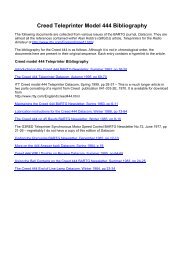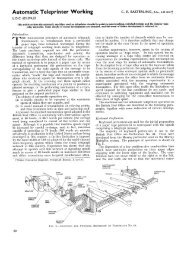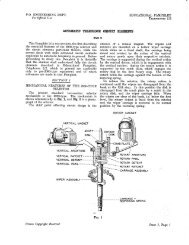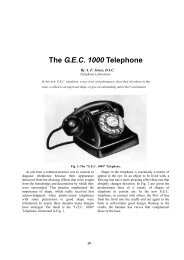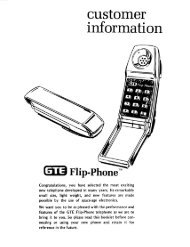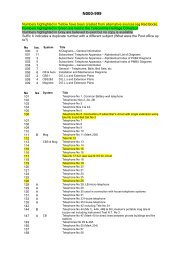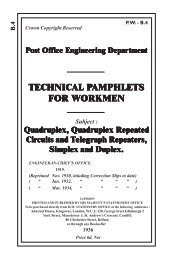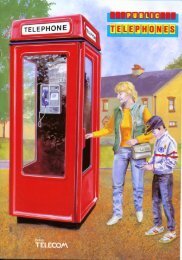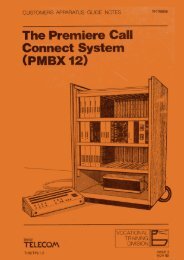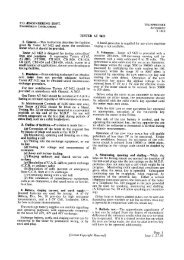TRAFFIC CONTROL TELEPHONE SYSTEMS Circuit - Sam Hallas
TRAFFIC CONTROL TELEPHONE SYSTEMS Circuit - Sam Hallas
TRAFFIC CONTROL TELEPHONE SYSTEMS Circuit - Sam Hallas
Create successful ePaper yourself
Turn your PDF publications into a flip-book with our unique Google optimized e-Paper software.
Page 46<br />
The operation of Relay LC completes a circuit for the driving of line switch SC as<br />
described above for an ordinary call, and also operates Relay BR. Line switch SC will<br />
drive, and its wipers SC5/6, and SC7/8, will control the operation of Relay IS. Relay<br />
IS controls Relay SR as before, the latter sending impulses to line. From line switch<br />
bank contacts 5 to 22, Relay IS will be operated on odd bank contact numbers and<br />
released on the even bank contact numbers causing Relay SR to send 17 reverse<br />
battery impulses to line. All selectors will be stepped to the ringing position and the<br />
bells will continue to ring until the Controller restores the “General Call” key. Actually<br />
line switch SC steps on to SC bank contact 40 when its drive circuit is broken at<br />
SC1/2 bank contact 40 through GCA1 being operated. It should be noted that GC4,<br />
GC5 and GC6 contacts connect 50 volt positive battery to line switch SC bank<br />
contacts 22, 24 and 26 to maintain the circuit for Relay IS, whilst GC3 provides 50<br />
volt positive to SC bank contacts 40, 42 and 44 for the same reason.<br />
When the “General Call” key is released Relay GCA is released, and at GCAI<br />
restores the drive circuit for line switch SC which again drives until it reaches its home<br />
position. When line switch SC wipers 5/6 reach SC bank contact 46 Relay IS releases<br />
and causes Relay SR to release, thereby sending a final impulse to line to clear down<br />
the selectors. When it reaches SC bank contact 49, Relays LC and GC are released at<br />
SC wipers 3/4. When line switch SC reaches its home position, its drive circuit being<br />
broken at wipers SCI /2, as already described.<br />
Prolonged Ringing<br />
If it is desired to prolong the ringing on a normal call, the Controller will operate<br />
the “Long ring” key before dialling. This will cause Relay GCA to operate, and at<br />
GCAI remove the 50 volt positive from line switch SC1/2 bank contact 40. Line<br />
switch SC will step, as before described, until it reaches this contact, when it will<br />
stop because the drive circuit is broken. Relay IS will remain operated and relay SR<br />
will continue to apply battery to line. When a sufficiently long ring has been given,<br />
the Controller will restore the “Long ring” key, which will release Relay GCA. On the<br />
fall back of GCA1, 50 volt positive will be applied to line switch SC 1/2 bank contact<br />
40 and restore the driving circuit, allowing line switch SC to drive home to its normal<br />
position as before. Relay LC is released when SC wipers 3/4 reach SC bank contact<br />
49.<br />
Time Sending<br />
To send a time signal, the Controller operates the circuit Speak key and a Time<br />
Sending key, which completes a circuit for Relay TS. Relay TS operates and locks<br />
over its own contact TS1 and Line switch SC3/4 bank contacts. Relay TS at TS3<br />
completes the circuit for Relay LC and TS2 connects positive to Line switch SC bank<br />
5/6 contact 28. The operation of Relay LC causes Line switch SC to step in the<br />
manner described for an ordinary call. Relay IS will operate and release on alternate<br />
steps of Line switch SC from SC bank contacts 5 to 27, thus sending 23 reverse<br />
impulses to line via Relay SR contacts. This will step all selectors to the time signal<br />
position. Relay GCA is also operated by the time sending key, removing the positive



